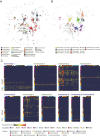Global diversity of microbial communities in marine sediment
- PMID: 33077589
- PMCID: PMC7959581
- DOI: 10.1073/pnas.1919139117
Global diversity of microbial communities in marine sediment
Abstract
Microbial life in marine sediment contributes substantially to global biomass and is a crucial component of the Earth system. Subseafloor sediment includes both aerobic and anaerobic microbial ecosystems, which persist on very low fluxes of bioavailable energy over geologic time. However, the taxonomic diversity of the marine sedimentary microbial biome and the spatial distribution of that diversity have been poorly constrained on a global scale. We investigated 299 globally distributed sediment core samples from 40 different sites at depths of 0.1 to 678 m below the seafloor. We obtained ∼47 million 16S ribosomal RNA (rRNA) gene sequences using consistent clean subsampling and experimental procedures, which enabled accurate and unbiased comparison of all samples. Statistical analysis reveals significant correlations between taxonomic composition, sedimentary organic carbon concentration, and presence or absence of dissolved oxygen. Extrapolation with two fitted species-area relationship models indicates taxonomic richness in marine sediment to be 7.85 × 103 to 6.10 × 105 and 3.28 × 104 to 2.46 × 106 amplicon sequence variants for Archaea and Bacteria, respectively. This richness is comparable to the richness in topsoil and the richness in seawater, indicating that Bacteria are more diverse than Archaea in Earth's global biosphere.
Keywords: marine sediment; microbial diversity; subseafloor life.
Copyright © 2020 the Author(s). Published by PNAS.
Conflict of interest statement
The authors declare no competing interest.
Figures






Similar articles
-
Diversity of prokaryotes and methanogenesis in deep subsurface sediments from the Nankai Trough, Ocean Drilling Program Leg 190.Environ Microbiol. 2004 Mar;6(3):274-87. doi: 10.1111/j.1462-2920.2004.00568.x. Environ Microbiol. 2004. PMID: 14871211
-
Abundance and distribution of Archaea in the subseafloor sedimentary biosphere.ISME J. 2019 Jan;13(1):227-231. doi: 10.1038/s41396-018-0253-3. Epub 2018 Aug 16. ISME J. 2019. PMID: 30116037 Free PMC article.
-
Metagenomic signatures of the Peru Margin subseafloor biosphere show a genetically distinct environment.Proc Natl Acad Sci U S A. 2008 Jul 29;105(30):10583-8. doi: 10.1073/pnas.0709942105. Epub 2008 Jul 23. Proc Natl Acad Sci U S A. 2008. PMID: 18650394 Free PMC article.
-
New Microbial Biodiversity in Marine Sediments.Ann Rev Mar Sci. 2021 Jan;13:161-175. doi: 10.1146/annurev-marine-032020-014552. Epub 2020 Aug 3. Ann Rev Mar Sci. 2021. PMID: 32746696 Review.
-
Two decades of describing the unseen majority of aquatic microbial diversity.Mol Ecol. 2012 Apr;21(8):1878-96. doi: 10.1111/j.1365-294X.2011.05362.x. Epub 2011 Nov 18. Mol Ecol. 2012. PMID: 22093148 Review.
Cited by
-
Microencapsulation and in situ incubation methodology for the cultivation of marine bacteria.Front Microbiol. 2022 Aug 22;13:958660. doi: 10.3389/fmicb.2022.958660. eCollection 2022. Front Microbiol. 2022. PMID: 36071955 Free PMC article.
-
Improving taxonomic classification with feature space balancing.Bioinform Adv. 2023 Jul 17;3(1):vbad092. doi: 10.1093/bioadv/vbad092. eCollection 2023. Bioinform Adv. 2023. PMID: 37577265 Free PMC article.
-
Decline of a distinct coral reef holobiont community under ocean acidification.Microbiome. 2024 Apr 17;12(1):75. doi: 10.1186/s40168-023-01683-y. Microbiome. 2024. PMID: 38627822 Free PMC article.
-
Deep Subseafloor Biogeochemical Processes and Microbial Populations Potentially Associated with the 2011 Tohoku-oki Earthquake at the Japan Trench Accretionary Wedge (IODP Expedition 343).Microbes Environ. 2023;38(2):ME22108. doi: 10.1264/jsme2.ME22108. Microbes Environ. 2023. PMID: 37331792 Free PMC article.
-
Improved resolution of microbial diversity in deep-sea surface sediments using PacBio long-read 16S rRNA gene sequencing.mSphere. 2024 Dec 19;9(12):e0077024. doi: 10.1128/msphere.00770-24. Epub 2024 Nov 12. mSphere. 2024. PMID: 39530673 Free PMC article.
References
-
- Parkes R. J.et al. ., A review of prokaryotic populations and processes in sub-seafloor sediments, including biosphere:geosphere interactions. Mar. Geol. 352, 409–425 (2014).
-
- Parkes R. J.et al. ., Deep bacterial biosphere in Pacific Ocean sediments. Nature 371, 410–413 (1994).
-
- D’Hondt S.et al. ., Presence of oxygen and aerobic communities from seafloor to basement in deep-sea sediment. Nat. Geosci. 8, 299–304 (2015).
Publication types
MeSH terms
Substances
LinkOut - more resources
Full Text Sources

